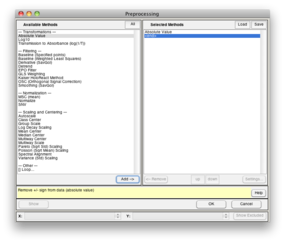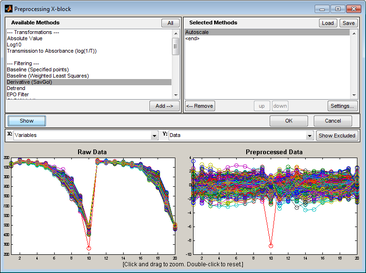Model Building: Preprocessing Methods: Difference between revisions
imported>Jeremy No edit summary |
imported>Jeremy No edit summary |
||
| Line 18: | Line 18: | ||
:: | :: | ||
{| | {| | ||
|- | |- | ||
| Line 28: | Line 28: | ||
|} | |} | ||
{| style="margin-left:18pt" | {| style="margin-left:18pt" | ||
|- | |- | ||
| Line 37: | Line 37: | ||
|} | |} | ||
{| style="margin-left:18pt" | {| style="margin-left:18pt" | ||
|- | |- | ||
| Line 46: | Line 46: | ||
|} | |} | ||
{| style="margin-left:18pt" | {| style="margin-left:18pt" | ||
|- | |- | ||
| Line 55: | Line 55: | ||
|} | |} | ||
{| style="margin-left:18pt" | {| style="margin-left:18pt" | ||
|- | |- | ||
| Line 64: | Line 64: | ||
|} | |} | ||
{| | {| | ||
|- | |- | ||
| Line 76: | Line 76: | ||
:Note: Some preprocessing methods, for example, the Savitzky-Golay method, require you to specify values for method-specific parameters before you can add the method to the Selected Methods pane. | :Note: Some preprocessing methods, for example, the Savitzky-Golay method, require you to specify values for method-specific parameters before you can add the method to the Selected Methods pane. | ||
{| | {| | ||
|- | |- | ||
| Line 88: | Line 88: | ||
:Note: Regardless of the other preprocessing steps selected, Autoscale or Mean Centering should typically be the final preprocessing step in the series. | :Note: Regardless of the other preprocessing steps selected, Autoscale or Mean Centering should typically be the final preprocessing step in the series. | ||
{| | {| | ||
|- | |- | ||
| Line 98: | Line 98: | ||
|} | |} | ||
{| style="margin-left:18pt" | {| style="margin-left:18pt" | ||
|- | |- | ||
| Line 107: | Line 107: | ||
|} | |} | ||
{| style="margin-left:18pt" | {| style="margin-left:18pt" | ||
|- | |- | ||
| Line 116: | Line 116: | ||
|} | |} | ||
{| style="margin-left:18pt" | {| style="margin-left:18pt" | ||
|- | |- | ||
| Line 125: | Line 125: | ||
|} | |} | ||
{| style="margin-left:18pt" | {| style="margin-left:18pt" | ||
|- | |- | ||
| Line 144: | Line 144: | ||
:: | :: | ||
{| | {| | ||
|- | |- | ||
| Line 153: | Line 153: | ||
|} | |} | ||
{| | {| | ||
|- | |- | ||
Revision as of 11:34, 29 July 2010
Table of Contents | Previous | Next
Preprocessing Methods
Data preprocessing describes any type of processing procedures that are performed on raw data to prepare it for another processing procedure and ultimately, analysis. Preprocessing linearizes the relationships among the variables in your DataSet and removes extraneous sources of variation that are of no interest to the analysis. A variety of preprocessing methods are available in Solo. This section describes the basic steps for setting up preprocessing rules for an analysis and verifying that the rules that you have set up are as you want them. Specific information about the different preprocessing methods that are available (such as the purpose of each method and when and how to use a specific method) is beyond the scope of this section.
Preprocessing window
You use the Preprocessing window to specify the preprocessing methods that you want to carry out for your data and in what order. The available methods are grouped by type (Filtering, Normalization, and so on) in the Available Methods (left) pane of the window. The methods that you select for preprocessing your data are displayed in the Selected Methods (right) pane. The methods are carried out in the order in which they are listed in the pane. The default selected method is Autoscale.
- Preprocessing window
| 1. | To open this window, do one of the following: |
|
|
| 2. | In the Available Methods pane, select the method by which you want to preprocess your data, and then click Add. |
- Note: Some preprocessing methods, for example, the Savitzky-Golay method, require you to specify values for method-specific parameters before you can add the method to the Selected Methods pane.
| 3. | Repeat Step 2 until you have selected all of the necessary preprocessing methods. |
- Note: Regardless of the other preprocessing steps selected, Autoscale or Mean Centering should typically be the final preprocessing step in the series.
| 4. | Optionally, after you have selected all of the necessary preprocessing methods, you can do one or more of the following: |
|
|
|
|
Note: The figure below shows preprocessing using default preprocessing methods on a 200 x 30 DataSet for a simple PCA model.
- Preprocessing using default preprocessing methods on a 200 x 30 DataSet for a simple PCA model
|
After you have selected preprocessing methods for your data, you can point your mouse cursor on the Preprocessing icon for a control in which you have loaded data. Tooltip text opens with preprocessing information.
- Tooltip text with preprocessing information

